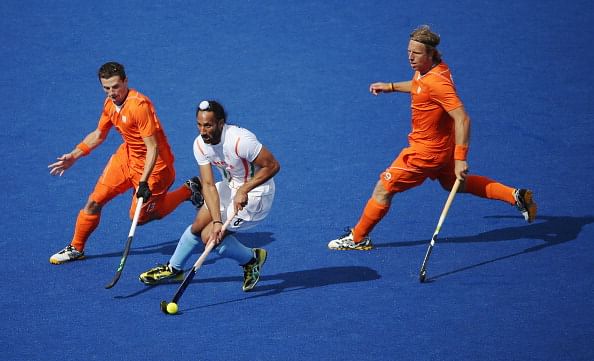
A lesson in Hockey from East and West - The best of both worlds
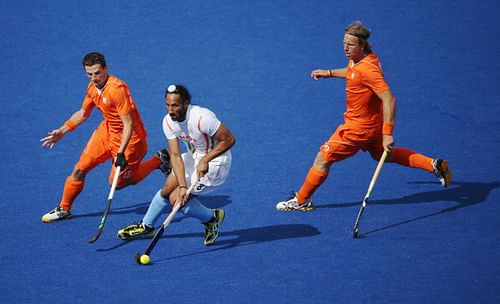
Background:
Once upon a time the West came to the East to learn the art of playing hockey. Yes, it was when East conquered the world. Now the tables have turned. It is time for the East to learn from the West; not only this, but clearly understand, what needs to be adopted and what not. When one is not aware of this, usually what happens is, that the wrong things are picked, and one jumps out of the frying pan into the fire. Only a very few, who are wise, know the difference and make the right choices, like the Aussies.
First, what the East – India and Pakistan – can learn from the West – Germany and Holland?
1. Technical and Tactical Skills:
- Space awareness: How to create and exploit space, individually and as a team.
- How to make the ball run faster, even than the fastest man on the earth, Usain Bolt. Asians run with the ball; Europeans run without the ball and make the ball run.
- Circulating the ball in the back and connecting it with the midfield players and the forwards, with ease and grace, on the run.
- Mastering the set plays, especially offensive & defensive Penalty corners.
- Goalkeeping
2. Planning and organization:
- Long term planning; with short term, mid term goals and performance indicators.
- Preparation and organization: Plan your work and work your plan.
- Beginning with a end in mind: Having a creative vision.
- Rock solid coach education, athlete centered coaching and administration structure in place.
- Uniformity in style of play and coaching, at all levels of the program.
3. Performance Enhancement team – PET:
Having a team of expert scientists behind the team; leaving nothing to chance and making the optimum use of all the available sport sciences – Psychology, Physiology, Nutrition and Periodization – to maximize team performance.
4. Innovation: Thinking out of the box
Just look the way Germans and the Dutch invent new skills and tactics and are way ahead of their competition. They sure invent and employ the new skills and tactics effectively and successfully, while the rest of the world just wonders what hit them! Further, as the opponents try to learn the new invention, they jump even further ahead, keeping their competitors circling in circles. For example, circulating the ball in the back. Germany won the 1982 Kuala Lumpur Junior World Cup while employing this tactic, whereas it took Asians a long time to figure out the importance of this strategy.
By the way, they have still not mastered it to the extent it needs to be, to be effective. Winners are innovators.
5. Team work:
There is hardly a nation where there are no differences, inner bickering and fighting among themselves. This is bound to happen as this is human nature. The beauty is to leave one’s differences behind and work as a team, with a common goal in mind, from top to the bottom as we are inter-dependant. One has to admire this quality of the Europeans, as they work as a team, on and off the field.
In this respect, India and Pakistan have quite some way to go. Yes, when they ruled the world they had one strong leader – Ashwini Kumar for India in the 60’s and Brigadier Atif for Pakistan in the 70’s and early 80’s respectively. Isn’t it true that “United we stand, divided we fall”?
6. Self awareness:
Self awareness is to know, what you are aware of – your strengths, and what you are not – your weakness. On top of this, it is important to learn how to optimize one’s strengths and cover one’s weakness, and have a plan to improve upon one’s weaknesses systematically. And keep continuing improving upon one’s strengths.
For example, in the 2010 Delhi World Cup final match, Australia surprised Germany by putting a forward on the German deep defender, while taking the 16’s. It was a bold decision by Coach Charlesworth! This affected Germany’s performance, and was one of the key strategic ploys for Australia to win a World Cup after 28 years. During the recently concluded 2012 London Olympics Games, in the semifinals, this tactic of Australia did not affect the Germans. In fact it backfired in a way. Germans had done their home work. They not only escaped this full court press net, but made successful transitions to launch attacks.
On a slightly surprising note, why did the Australian coaching staff did not change this particular strategy at half time, when it was obvious that it was not working to the degree as they had anticipated? Food for thought.
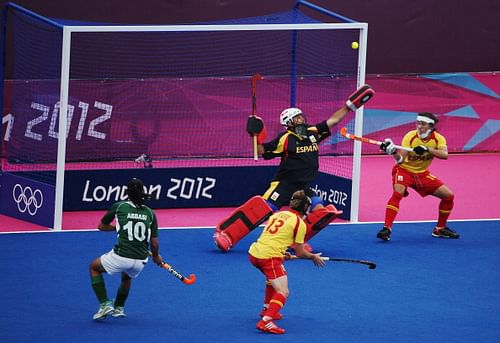
We play football from the heart and the Europeans play football from their head
- Brazilian soccer superstar, Pele
Now, what the West – Germany, Holland, England and Spain – can learn from the East?
Mainly technical skills, which facilitate creativity and flair
1. Individual ball control and elimination skills in a tight and pressurized game situation.
2. Silky skills, body feints, deception and dexterity. They have almost vanished and have been replaced by semi brute force and power.
3. Tackling: Germany has sharply deviated from indoor style, flat footed tackling and embraced the upright style of tackling, which Asians were masters and famous for. Now the Asian deep defenders have adopted the flat footed style tackling. No wonder they are easily eliminated during the run of play. Germany is very smart in taking their opponents deliberately for a walk in the wrong direction (in the woods) and leaving them feeling lost, while knowing and taking the right path, and enjoying the journey.
4. Scoring soft, classic goals with grace, the way Romario and Messi from soccer score and Hasan Sardar and Balbir Singh from Railways, used to score. They had a variety of 1 on 1 dodges and skills in a tight and crowded game situation, in order to score. Nowadays, one main skill employed, is the hard and wild backhand sweep hit. Though nothing being wrong with it, as lots of goals are scored, it is very dangerous. There is a time and place to employ each and every skill. Isn’t variety the spice of life?
5. Mastery of individual position, while being versatile enough to play other positions too. In this regard, there aren’t many current players who come to mind, and stand out. Yes, I agree, the game – strategies and tactics – have also changed a lot.
6. There is a specific Role and Responsibility and a style/technique to play each and every position on the field, as the old Asian masters used to display. Now players are jack of all trades and master of none. Let’s put it this way, can we think of very many lasting memories or moves or classic goals being scored, during the 2012 London games? Players who were hard to forget, as they demonstrated, pure skill, footwork, change of pace/direction and imagination? We can still witness this in soccer and basketball.
With all due respect, the current Asian players’ game and performance is not even close to the outstanding game of the players and teams of the 60’s, 70’s and 80’s, when they consistently ruled the world and were highly ranked. Lately, the individual skills, game sense and performance, has vastly declined. With the exception of Sardar Singh of India, and a few others, who comes close to the playing to the standard of the old timers? Believe it or not, this is a naked fact!
Key reasons for this decline, to name a few, are:
- Lack of solid system and structure in place.
- No organized junior development programs.
- Top level coaches not working with the juniors.
- Lack of coach education.
- Trying to imitate the Europeans, especially their bad habits.
Asians have become like a man trying to sail with his feet in 2 boats, and we know, where it ends as. In other words, they have forgotten how to play their own style of play effectively, and also don’t know how to play the European style of play effectively.
Conclusion:
With the power balance heavily tilted towards the west, one not-so-good thing has happened. The soft silky Asian skills, which added flair and delicate creativity to the game, have gone out of fashion. In fact it has almost died, replaced with semi brute force.
The way some of the top European players play, in certain game situations, reminds me of a mad bull in a China shop – Bulldozing his way, without even a tinge of grace, art or courtesy. This is not good for hockey, as it has made our game a physical and rough one.
Please refer to the photos 1 – 4; they reveal, what I am trying to convey.
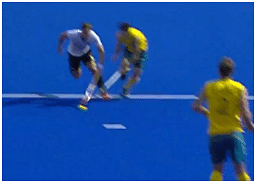
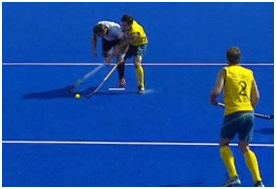
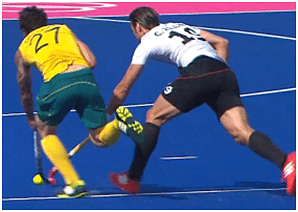
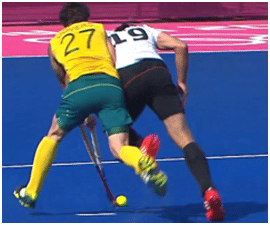
Photo’s 1 and 2 depict Christopher Zeller of Germany on top of the Aussie circle, and being tackled and chased from the left by Kieran Govers of Australia, in the 2012 London Olympic Games semifinal match. Christopher could have easily adjusted the ball and his body position, while bringing the ball in front of him, to create more quality options. Furthermore, he could have drawn the ball to his right, and entered the circle to take a shot on goal. Instead, he decided to bulldoze to his left, and get into a pushing and shuffling contest. Not a wise move. Please refer to photo 2 and 4, which says it all. Is this hockey at its best or a wrestling match? And that also displayed by a two time Olympic gold medallist- Chrissie the great!
There is something seriously wrong with our game, and this should not be taken lightly.
Since the East have not been able to perform well enough to stay in the top 4 of world rankings, their style of play has also been completely discarded. Yes, their former style of play would not have won them medals in this modern era without making massive tactical adjustments and improvements, but at the same time, their individual skills and flair can still be employed in various game situations to add a unique and beautiful angle to the game. And this is what is needed the most at this stage of our game.
Winning is important, and Germany would still have won, without employing the bullying tactics in certain game situations, as mentioned above. Just the way Spain won the 2010 soccer World Cup final against Netherlands and than the 2012 Euro Cup, demonstrating class and skills of the highest level.
Don’t we enjoy the beautiful game of soccer, as played by Spain, Germany and Brazil? These 2 Europeans teams – Spain and Germany, are a shinning example. So is the German hockey team, winning back to back Olympic gold medals! A great achievement indeed!
It is good to be important (by winning) but it is equally important to be good!
I miss the graceful and skilful plays of German players like Eckhard Schmidt-Opper and Heiner Dopp, to name a few, of the mid 80’s, who were a beauty to watch, as they imitated the great Asian players of that era. In my opinion, Maximilan Muller, their gold medal winning captain, has that grace and class!
Haven’t we thrown the baby out with the bath water? In other words, while discarding the Asian style of play, haven’t we also discarded their brilliant individual skills, which were a beauty to watch? Isn’t it time Europeans blended the silky Asian skills, with the state of the art European tactics and make our game even more attractive and spectator friendly?
And the East should study and employ, the strong points of the West. Of course, the East and West can blend the best of each other and improve the standard of the game, as has been done by the west while practising Yoga, and improving their spiritual lifestyle.